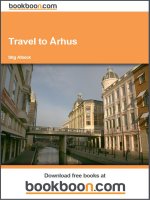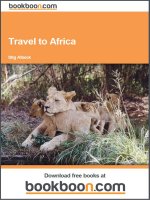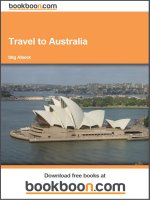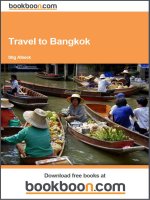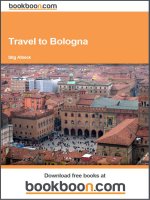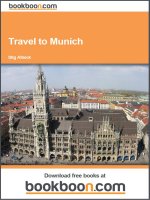Travel to Johannesburg & Pretoria potx
Bạn đang xem bản rút gọn của tài liệu. Xem và tải ngay bản đầy đủ của tài liệu tại đây (3.23 MB, 31 trang )
Download free ebooks at bookboon.com
Download free ebooks at bookboon.com
Johannesburg & Pretoria
© 2008 Stig Albeck & Ventus Publishing ApS
Translation: Sandra Cliff
All rights and copyright relating to the content of this
book are the property of Ventus Publishing ApS, and/or its
suppliers. Content from ths book, may not be reproduced
in any shape or form without prior written permission from
Ventus Publishing ApS.
Quoting this book is allowed when clear references are made,
in relation to reviews are allowed.
ISBN 978-87-7061-294-4
1st edition
Pictures and illustrations in this book are reproduced according
to agreement with the following copyright owners:
Brian McMorrow & Gorm Albeck.
The stated prices and opening hours are indicative and may
have been subject to change after this book was published.
Download free ebooks at bookboon.com
Johannesburg & Pretoria
4
Kapiteloverskrift ONLIBRI
Download free ebooks at bookboon.com
Please click the advert
Johannesburg & Pretoria
5
A visit to
Johannesburg &
Pretoria
www.joburg.org.za
www.gauteng.net
www.southafrica.net
The metropolis of Johannesburg is the economic
locomotive of southern Africa, and it is one of the
large and interesting cities of this continent. The
city is the largest in South Africa and consists of
what one might well think of as two cities: the old
city and the modern Sandton, where there are large
shopping malls and modern buildings. The old
part of the city has a number of tourist attractions,
such as the district of Soweto, which is known all
over the world because the former President,
Nelson Mandela, came from that area.
The capitol of South Africa, Pretoria, is located in
the middle of the country’s enormous gold and
diamond industries; a location which has
influenced both Pretoria and Johannesburg. As the
capitol, Pretoria has a number of large and
impressive public buildings. There is also a
number of beautiful historic mansions as well as
some very good museums.
Johannesburg and Pretoria are both surrounded by
the beautiful countryside of South Africa. There
are several national parks in addition to exciting
cultural and industrial historic sites, such as the
luxurious Sun City and the Cullinan Diamond
Mine where the largest diamond in the world was
found in 1905.
Happy journey!
A visit to Johannesburg & Pretoria
Download free ebooks at bookboon.com
Johannesburg & Pretoria
6
Historical outline
Johannesburg
The area around Johannesburg has been inhabited
for millions of years, but despite its size,
Johannesburg is a rather young city. In the 19
th
century, many Boer farmers arrived in the area and
they cultivated large parts of the countryside. This
was especially the case, after they moved inlands
from Cape Town in 1836. However, an actual city
what not founded at that time.
The Australian, George Harrison, found gold here
in 1886, which was the start signal for a hectic gold
rush. The government officials, Johann Rissik and
Johannes Joubert, were sent from Pretoria to the
area where gold had been found. They selected the
location for the foundation of the town
Johannesburg, which was subsequently named
after them. The first gold was found in Barberton,
but soon after even greater deposits were found in
Witwatersrand.
The gold brought an influx of newcomers, not
only from other parts of southern Africa, but also
from Europe and North America. In just five
years, Johannesburg became the largest city in
South Africa. Due to the economic interest of the
area, tension arose between the Dutch Afrikaans
and the British – this resulted in the Second Boer
War, and Great Britain gained control also of this
part of South Africa.
After the creation of the Union of South Africa in
1910, regulations for non-Europeans were put into
effect in Johannesburg and the Transvaal.
Particular districts were allocated to the non-
Europeans, such as Soweto where the population
increased greatly during the 1940s.
With the wealth from the gold mines,
Johannesburg's industrial production increased
during the first half of the 20
th
century, and a
number of cultural institutions were established as
well. The many mining and industrial jobs
continued to attract black people from the poor
rural districts, and the city’s black districts soon
became over-populated slums. Johannesburg’s
central business district shot up, and there were
many international hotels, skyscrapers and
entertainment offers for the many wealthy white
people and travelling business people. The white
districts were as modern as any similar district in
Europe or North America, whilst the deprived
districts for black people grew without economic
investment. Political pressure continued to mount
against the white regime which had been
established after the National Party’s victory in the
1948 elections.
In 1976, riots broke out in Soweto. Following 12
months of unrest, the riots were suppressed, but
this gave nourishment to the black opposition’s
battle for political influence. After several
uprisings, the political structure of the country
changed in 1990. Political freedom was introduced
and presidential elections were held in 1994.
Nelson Mandela from Soweto was elected as the
first black president.
The changes to the political system had
consequences for Johannesburg. Many black
people moved into the central business districts
where the financial sector was located. Businesses
and the Stock Exchange moved to new areas,
primarily to the northern suburb of Sandton.
Hotels also closed down and relocated, and the
city centre changed radically in just a few years.
Nowadays, effort is being made to re-establish
central Johannesburg as a place of attraction to
both investors and tourists.
Historical outline
Download free ebooks at bookboon.com
Johannesburg & Pretoria
7
Pretoria
The so-called Ndebele people were the first to
settle in the area now known as Pretoria. They
named their town after one of their chiefs,
Tshwane, which means “small monkey”. During
the Zulu Wars, their town was attacked and the
Ndebele people were forced to leave in 1832.
In 1836, the Dutch families began their great
“Voortrekker-karavane” from Cape Town to the
interior of the country. They came to the Pretoria
area which they began to cultivate. Later, in 1855,
the “Voortrekker” leader, Martinius Pretorius,
founded the city of Pretoria. He named the town
after his father, Andries Pretorius, who had
become a Dutch national hero following the
victory over the Zulus in the battle at Blood River.
Pretoria soon became the capitol of the Boer-
dominated South African Republic (Zuid-
Afrikaanche Republik).
The capitol developed until the first war with
Great Britain between 1899 and 1902. In 1900 the
British captured Pretoria, and the war concluded
with the signing of a peace treaty. This became the
end of the South African Republic, which in 1910
was replaced by the Union of South Africa.
Pretoria became the administrative capitol,
whereas Cape Town in Cape Province became the
legislative capitol. At the same time, Pretoria was
made the capitol of the Transvaal Province.
Due to the new status of the city, a number of
large public buildings were built, including the
impressive government offices, the Union
Buildings which were taken into use in 1913.
Economically, the nearby Johannesburg developed
by leaps and bounds, whilst Pretoria managed
administrative and legal affairs. Pretoria was
therefore often in the international news, not least
after the introduction of Apartheid.
Pretoria benefited financially from the rich gold
and diamond deposits, and a number of modern
buildings and suburbs were built during the
second half of the 20
th
century.
Pretoria has preserved many of its historical
buildings. Nowadays, visitors can explore the
history of the city by going to see these old
buildings with their historical interior, or by
visiting other places of historical or cultural
interest.
Historical outline
Download free ebooks at bookboon.com
Please click the advert
Johannesburg & Pretoria
8
Tour 1: Johannesburg
1. Sandton
Sandton
The suburb of Sandton north of the historical
centre of Johannesburg is the new, modern centre
where a number of businesses now have their
main offices. There are hotels, shopping centres
and many activities.
Sandton is one of the wealthier districts of
Johannesburg, and there are many beautiful houses
and large gardens. Sandton therefore stands in
sharp contrast to other parts of Johannesburg and
South Africa.
Tour 1: Johannesburg
© Deloitte & Touche LLP and affiliated entities.
360°
thinking
.
Discover the truth at www.deloitte.ca/careers
© Deloitte & Touche LLP and affiliated entities.
360°
thinking
.
Discover the truth at www.deloitte.ca/careers
© Deloitte & Touche LLP and affiliated entities.
360°
thinking
.
Discover the truth at www.deloitte.ca/careers
© Deloitte & Touche LLP and affiliated entities.
360°
thinking
.
Discover the truth at www.deloitte.ca/careers
Download free ebooks at bookboon.com
Johannesburg & Pretoria
9
2. The Johannesburg Fort
Kotze Street
Modern Johannesburg meets the old part of town
in the Constitution Hill area. You can visit the
Johannesburg Fort which was built there as a
garrison in the 1890s. After the war with the
British, the fort became a prison where a number
of political prisoners were incarcerated. Nowadays,
the constitutional court of South Africa is located
in the area.
3. The Telcom Tower
Bourke Street
This tower, which used to be called, Hillbrow
Tower, is 270 metres high. It is thereby the tallest
building in Africa – if you exempt the chimneys of
power stations. The tower used to be a main
tourist attraction with its observation room and
rotating restaurant. However, both of these have
been closed since 1981. The tower was built
between 1968 and 1971.
4. The Johannesburg Art Gallery
Joubert Park
The Johannesburg Art Gallery was founded in
1910, and the exhibition building in Joubert Park,
which was completed in 1915, has been expanded
several times.
The 15 exhibition halls contain a large collection
of works from the 19
th
century to present day.
British, Dutch and South African artists are
represented in the exhibition.
5. The Carlton Centre
Main Street
Standing at 223 meters high and built between
1967 and 1974, the Carlton Centre was once the
tallest office building in the southern hemisphere.
It is still the tallest office building in Africa. It is a
50 storey building, and there is a wonderful view
across Johannesburg from the observation deck
on the top floor.
6. The Johannesburg Town Hall
Market Street
The Town Hall in Johannesburg is one of the
characteristic historical buildings of the city. Some
of the Gauteng region’s administrative offices are
located there. The famous pipe organ, which was
built in Norwich and installed in 1916, is also
found there.
7. The Market Theatre
Wolhuter Street 56
www.markettheatre.co.za
The name of the Market Theatre relates to the
former use of the building. At the beginning of the
20th century, it was a food market. Much of the
original interior of the building is still intact, which
makes it something worth seeing. This beautiful
Tour 1: Johannesburg
Download free ebooks at bookboon.com
Johannesburg & Pretoria
10
building contains several performance stages in
addition to a number of eating establishments.
8. Museum Africa
Bree Street 121
Museum Africa was set up in a former market
building and opened1994. It depicts, in a modern
way, the complex history of southern Africa,
starting with Johannesburg. The thematic
exhibitions give the visitor an insight into the daily
life of the miners.
9. The Apartheid Museum
Northern Parkway/Gold Reef Road, Ormonde
www.apartheidmuseum.org
The Apartheid Museum opened in 2001 and
relates the South African history of Apartheid; its
introduction, regulation and discontinuation.
The introduction of the policy was formalized in
1948, when the Government of the National Party
made the Apartheid laws which determined the
structure of society for decades. The symbolic end
of the period came in 1994 when Nelson Mandela
was elected president.
The museum presents the visitor with detailed
insights into daily life for various segments of the
population as well as the general development of
the South African Republic.
10. Gold Reef City
Xavier Road, Ormonde
www.goldreefcity.co.za
Gold Reef City is a fascinating historical and
recreational area where one is taken back to the
19
th
century and the era of gold digging. The area
is built up around the old mine shaft No. 14,
Crown Mine, which was mined for gold from 1887
to 1975. 1400 tons of gold were produced from
the mine. A mining town from Victorian times has
been reconstructed and, besides the interesting
buildings, there is also entertainment. Probably the
most exciting attraction is the 200 metres deep
mine shaft, which is open to visitors.
11. Soweto
Tour 1: Johannesburg
Download free ebooks at bookboon.com
Johannesburg & Pretoria
11
Soweto
www.soweto.co.za
The name, Soweto, is an abbreviation of South
Western Townships. The history of Soweto goes
back to 1905, when people started relocating from
Johannesburg to Klipspruit, which was named
Pimville, before it was called Soweto. In the 1940s,
the area became flooded with black settlers, and
that was the start of present day Soweto.
Soweto has been at the heart of several riots,
including those of 1976. Of all of Soweto’s
inhabitants, Nelson Mandela is the best known.
The area has been deprived for many years, and if
visiting this place, it is recommended that you take
one of the official, guided tours.
11a. The Hector Pietersen Museum
Maseko Street 8288, Orlando West
This museum was created in memory of the riots
in Soweto in 1976. Hector Pietersen was one of
the first people to be shot during this violent time.
The museum portrays uprisings, the people, places
and events.
11b. The Mandela Family Museum
Ngakane Street 8115, Orlando West
Nelson Mandela’s former home in Soweto now
contains a museum which has information about
the former South African president, Nelson
Mandela, and about the cause he fought for.
Tour 1: Johannesburg
Download free ebooks at bookboon.com
Please click the advert
Johannesburg & Pretoria
12
Tour 1: Johannesburg
Increase your impact with MSM Executive Education
For more information, visit www.msm.nl or contact us at +31 43 38 70 808
or via
the globally networked management school
For more information, visit www.msm.nl or contact us at +31 43 38 70 808 or via
For almost 60 years Maastricht School of Management has been enhancing the management capacity
of professionals and organizations around the world through state-of-the-art management education.
Our broad range of Open Enrollment Executive Programs offers you a unique interactive, stimulating and
multicultural learning experience.
Be prepared for tomorrow’s management challenges and apply today.
Executive Education-170x115-B2.indd 1 18-08-11 15:13
Download free ebooks at bookboon.com
Johannesburg & Pretoria
13
Tour 2: Pretoria
12. Kruger House
Church Street West 60
www.nfi.org.za/km/khkruger.htm
When the elegant Kruger House was erected in
1884, it was very modern. It was, for example, one
of the first houses in the city to get electricity.
Kruger House was both home and state residence
for Transvaal’s President, Paul Kruger. You can
feel the distinguished ambience in the presidential
reception room. You can almost imagine seeing
John Kruger sitting and conversing with Cecil
John Rhodes or other famous visitors.
The interior of the house gives an insight into the
lives of the former Paul Kruger and his wife
Gezina. You can see Paul Kruger’s grave at
Church Street Cemetery, which is just west of the
house.
13. Church Square
Church Square
Church Square is Pretoria’s central square. It has a
number of historical buildings. In the middle of
the square is a stature of the Boer leader and
Transvaal’s former President, Paul Kruger.
The beautiful and characteristic buildings include
the court house, Palace of Justice, where the trials
of, for instance, Nelson Mandela took place in the
1960s.
The former national bank, Old Reserve Bank, is
located next to the Palace of Justice. The beautiful
building, Old Raadsal, still houses some of the
city’s administrative offices, and to the west lies
the General Post Office.
14. The Union Buildings
Government Avenue
The Union Buildings are the offices of the South
African Government. This imposing building
complex was designed by the well-known British
colonial architect, Sir Herbert Baker, and it is
regarded as his masterpiece.
The Union Buildings have been the seat of both
the government and the South African President
since 1913. It was in these buildings that Nelson
Mandela became the first black president of South
Africa.
The elevated position of the Union Buildings
provides a wonderful view across Pretoria, and
you get a feel of both the history of the South
African capitol and its modern areas.
15. The Pretoria Art Museum
Arcadia Park
www.pretoriaartmuseum.co.za
The Pretoria Art Museum has an outstanding
collection of works by South African artists.
Tour 2: Pretoria
Download free ebooks at bookboon.com
Please click the advert
Johannesburg & Pretoria
14
There are changing exhibitions where more than
3,000 pieces are shown in rotation. The museum
continues to expand its collection.
16. Melrose House
Jacob Maré Street 275
www.melrosehouse.co.za
In 1886, the well-to-do George Heys built this
mansion in a distinguished mixture of Victorian
and Edwardian styles.
After Great Britain re-conquered the city during
the Boer War of 1899-1902, Lord Roberts installed
the British military headquarters in the mansion in
1900. Due to the Peace Treaty of Vereeniging, the
war was over, and the two Boer republics became
British Crown Colonies.
17. The Transvaal Museum of Natural
History
Paul Kruger Street
www.nfi.org.za/tmpage.html
Transvaal museum is a museum of natural history
where you can see a number of collections on
exhibition. There are numerous stuffed animals, a
whale skeleton and fossils that are millions of years
old. The latter were found in the caves of
Stekfontein and Kroomdrai.
Tour 2: Pretoria
Get “Bookboon’s Free Media Advice”
See the light!
The sooner you realize we are right,
the sooner your life will get better!
A bit over the top? Yes we know!
We are just that sure that we can make your
media activities more effective.
Download free ebooks at bookboon.com
Johannesburg & Pretoria
15
18. Pretoria City Hall
Visagie Street/Paul Kruger Street
Pretoria City Hall was dedicated in 1935. It was
designed in a style typical of the era, adapted from
Italian Classicism.
In front of the City Hall there are statues of
Martinus Wessel Pretorius and Andries Pretorius
who founded the city. The statues were built in
1955, in connection with the anniversary of the
town.
19. National Cultural History
Museum& the African Window
Visagie Street 149
www.nfi.org.za/nchm/nchmindex.htm
The former National Museum, Staatsmuseum of
the South African Republic, was in 1964 divided
into the Transvaal Museum of National History
and the National Cultural History Museum. The
museum was inaugurated in 1997. The large and
interesting collection includes everything from
archaeological findings to South African craft ware.
One part of the museum, the African Window, is a
celebration of the many different people and
cultures of South Africa.
20. The Correctional Services
Museum
Potgieter Street
Museum/Museum.htm
This prison museum depicts the development of
South Africa’s penal system. You can see the cells
and learn about daily life of the inmates. The
exhibition includes a number of objects which
have been made illegally in the prison and
confiscated by the authorities.
21. The Voortrekker Monument and
Museum
Monument Hill
The Voortrekkers were white Boers, who farmed
the land. During the 1830s and 1840 many of
them moved inlands and created settlements, away
from the Cape Province. In 1838 the great Battle
of Blood River took place. The king of the Zulus,
King Dingane turned back on a settlement
agreement, and sent thousands of his warriors to
fight the Voortrekkers, who defeated the Zulus.
In 1938, the African Broederbond repeated the
journey from Cape Town to Pretoria in celebration
of the 100
th
anniversary of the event. At the end,
there were almost 200,000 participants who
finished up at Monument Hill next to the southern
entrance to Pretoria.
The enormous Voortrekker Monument, built in
granite, was dedicated in 1948. At the local
museum, you can explore a range of objects from
the history of the Voortrekkers.
Tour 2: Pretoria
Download free ebooks at bookboon.com
Johannesburg & Pretoria
16
Tour 2: Pretoria
Download free ebooks at bookboon.com
Please click the advert
Johannesburg & Pretoria
17
Day Tours from
Johannesburg
22. Lion Park
Muldersdrift Road, Northriding, 35 km NW
www.lion-park.com
In the safari park, Lion Park, you can get close to
many of Africa’s animals; not least the lions, but
also leopards, hyenas, caracal (or African Lynx)
and many others. There are also large areas where
some of the more harmless animals, such as
giraffes, zebras, and antelopes can be observed.
The Lion Park opened in 1996 and has, over the
years, set up several activities with and amongst
the animals. The visitor can take a tour by car
through the park and see the enclosures with both
the common and the white lion.
In an area with baby animals, you can learn about
their fascinating lives and the conditions, under
which they grow up. Meanwhile, you will receive a
lot of information about, for instance, animal
protection.
Day Tours from Johannesburg
GO T -THE-ENER GY-T O-LEAD.COM
We believe that energy suppliers should be renewable, too. We are therefore looking for enthusiastic
new colleagues with plenty of ideas who want to join RWE in changing the world. Visit us online to find
out what we are offering and how we are working together to ensure the energy of the future.
Download free ebooks at bookboon.com
Johannesburg & Pretoria
18
23. The Cradle of Humankind
50 km NW
www.cradleofhumankind.co.za
The Cradle of Humankind is the name of an area
where hundreds of objects from early human life
has been found, including fossils and stone tools.
There are more than 40 excavations, some of
which are open to the public.
23a. The Sterkfontein Caves
www.sterkfontein-caves.co.za
A visit to the Sterkfontein Caves can successfully
be combined with a visit to the Cradle of
Humankind. The oldest human ape was found
there in 1936, and this set extensive archaeological
excavation work in motion.
Thus far, more than 500 remains have been found
in the Sterkfontein Caves, including skulls from
early human species. The work has brought to
light thousands of tools, and fossils of animals and
trees.
The limestone caves in Sterkfontein are millions of
years old and worth a visit.
24. Cullinan Diamond Mine
Cullinan, 120 km NE
www.debeersgroup.com
This diamond mine, which is owned by De Beers,
is located in the town of Cullinan. The mine was
opened in 1902 and is still mined. The mine
became widely known when the world’s largest
diamond was found there by Frederick Wells and
named, The Cullinan Diamond. The diamond,
which measured 3,106.75 carat and weighed
621.35 grams, was cut into several pieces. The
largest stone was polished into 74 facets and
mounted on the sceptre of the British Crown. The
diamond was called the Great Star of Africa.
You can visit the place by taking a tour from either
Johannesburg or Pretoria. You will, for example,
gain insight into the work in the diamond mine
and what it has produced.
If you are interested in the diamond production in
South Africa, you can make the longer trip to the
diamond centre, Kimberly, where you can see the
enormous and deep man-made mine shaft.
Because of its tremendous size, this mine is a
unique sight. There used to be a mountain where
the hole is now, and in 1866 diamonds were found
there. This resulted in a diamond rush and
newcomers arrived and began digging for precious
stones. In 1914, when the mine closed, the hole
had become 215 metres deep, and its
circumference was 1.6 kilometres long. 2,722
kilograms of diamonds had been found in total.
There are five such holes in South Africa. The
largest and deepest is found in Jagersfontein, south
of Kimberley.
Day Tours from Johannesburg
Download free ebooks at bookboon.com
Johannesburg & Pretoria
19
25. Sun City
Sun City, 120 km NW
www.suninternational.com
Sun City is a fantastic entertainment park in the
middle of rural South Africa. There are luxury
hotels, golf courses, casinos and a delightful
artificial beach. The entire park was built in an old
volcanic crater and opened in 1979.
Sun City was built in the Bophutatswana
homeland. In the South African homelands,
casinos and erotic entertainment were allowed, in
contrast to the rest of South Africa. The park was
therefore built in the middle of nowhere, but still
close enough to Johannesburg and Pretoria to
make Sun City a popular location.
The hotel, Palace of the Lost City, with its towers
and rich ornamentation, is the jewel in the crown.
This luxurious palace was built around a legend of
lost people and their magnificent city.
26. Pilanesberg National Park
Pilates National Park, 150 km NW
www.nature-reserve.co.za/pilanesberg-park-
north-west.html
In the Pilanesberg National Park you can
encounter the Big Five in African wildlife:
elephants, leopards, lions, rhinos and water
buffalos. The term, Big Five was formerly a
hunting term, used about the most dangerous
animals; with the water buffalo being the most
dangerous. The Big Five was, in other words, not a
reference to size.
The 135,000 acres of park are situated in a circle
around a central lake. This is because the entire
area was a volcanic crater. Nearly all of southern
Africa’s wildlife is represented. In the early 1980s,
more than 6,000 animals were introduced from
other parks. These included lions from the Etosha
National Park in Namibia. By far the majority of
the animals have acclimatized to the beautiful area,
and they constitute a harmonious whole.
There are about 200 km of roads in the park which
can easily be accessed with an ordinary car. It is
possible to stay in the park, and there are several
places where you can eat in natural surroundings
whilst observing the interesting wildlife.
Day Tours from Johannesburg
Download free ebooks at bookboon.com
Please click the advert
Johannesburg & Pretoria
20
Day Tours from Johannesburg
Contact us to hear more
Who is your target group?
And how can we reach them?
At Bookboon, you can segment the exact right
audience for your advertising campaign.
Our eBooks offer in-book advertising spot to reach
the right candidate.
Download free ebooks at bookboon.com
Johannesburg & Pretoria
21
Visiting Johannesburg with
children
Adventureland, Sandton Field & Study Centre
(William Nicol Road, Sandton)
Gold Reef City (Xavier Road, Ormonde):
www.goldreefcity.co.za
Johannesburg Zoo (Jan Smuts Avenue, Parktown):
www.jhbzoo.org.za
Lion Park (Muldersdrift Road, Northriding, 35 km
NW):
www.lion-park.com
Shopping in Johannesburg
The city’s shopping centres:
Clearwater Mall (Christiaan de Wet Road/Hendrik
Potgieter Drive):
www.clearwatermall.co.za
Cresta Mall (Beyers Naude Drive):
www.crestashoppingcentre.co.za
Dobsonville Shopping Centre (75 Mercy Park)
Eastgate Mall (Bradford Road):
www.eastgateshops.com
Killarney Mall (60 Riviera Road):
www.killarneymall.co.za
Oriental Plaza (Bree Street):
www.orientalplaza-fordsburg.co.za
Sandton City (Sandton Drive/Rivonia Road):
www.sandtoncity.com
Sandton Shopping Centre (Nelson Mandela
Square, Sandton):
www.sandtonsquare.com
Southgate Mall (Columbine Road/Rifle Range
Road)
Village Walk Shopping Centre (Maude
Street/Rivonia Road):
www.villagewalk.co.za
Public transport in
Johannesburg
Johannesburg Airport:
www.airports.co.za
Children / Shopping / Transportation
Download free ebooks at bookboon.com
Johannesburg & Pretoria
22
Visiting Pretoria with
children
Lion Park (Muldersdrift Road, Northriding, 35 km
NW):
www.lion-park.com
Pretoria Zoo (Boom Street):
www.zoo.ac.za
Shopping in Pretoria
The city’s shopping centres:
Arcadia Centre
De Bruyn Park
Centurion City
Jacaranda Centre
Menlyn Shopping Centre
Sanlam Centre
Standard Bank Centre
Sunny Park
Wonderpark
Public transport in Pretoria
Pretoria City Transport:
www.tshwane.gov.za/busbooklet.cfm
Children / Shopping / Transportation
Download free ebooks at bookboon.com
Johannesburg & Pretoria
23
Facts about South Africa
Political
Official name Republic of South Africa
Capital Pretoria
Form of government Republic
Head of state Thabo Mbeki
National Day 27 April
Acquired independence Established as a country 31 May 1910
Independent from Great Britain as a republic 31 May 1961
Main religion Christianity
Languages Afrikaans, English, Isindebele, Isixhosa, Isizulu, Sepedi,
Sesotho, Setswana, Siswati, Tshivenda and Xitsonga
Area 1,219,080 km
2
Population 44,820,000 (2001)
Facts about South Africa
Download free ebooks at bookboon.com
Please click the advert
Johannesburg & Pretoria
24
Borders on
North Namibia, Botswana, Zimbabwe, Mozambique, Swaziland
South -
East South Africa surrounds the independent state of Lesotho
West -
Highest Mountains
Mafadi 3,450 metres
Ben Macdhui 3,001 metres
Kompadberg 2,502 metres
Seweweekspoortpiek 2,325 metres
Toverkop 2,240 metres
Grootwinterhoekpiek 2,077 metres
Sneeuberg 2,026 metres
Du Toits Peak 1,995 metres
Nooitgedacht 1,852 metres
Renosterkop 1,690 metres
Facts about South Africa
THE BEST MASTER
IN THE NETHERLANDS
Download free ebooks at bookboon.com
Johannesburg & Pretoria
25
Largest Lakes
Gariep Dam Lake 360 km²
Vaal Dam Lake 300 km²
Lake Fundudzi km²
Longest Rivers*
Orange River 2,092 km
Limpopo 1,800 km
Vaal 1,210 km
Molopo River 960 km
Nossob River 800 km
Great Fish River 644 km
Tugela 520 km
Breede River 337 km
Berg River 294 km
Sundays River 250 km
Mngeni 232 km
*Some of these rivers are situated partly in other countries than South Africa.
Largest Cities
Johannesburg 8,837,000
Kapstaden 3,653,000
Durban 3,192,000
Port Elizabeth 1,572,000
East London 958,000
Facts about South Africa
